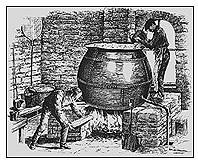|
The 19th Century Brewery Worker.
Many early historians of the brewing industry have left behind claims that employment in the typical nineteenth century brewery was among the most unpleasant work in American industry. In 1910, Herman Schluter published THE BREWING INDUSTRY AND THE BREWERY WORKERS' MOVEMENT IN AMERICA. Schluter had little good to say about brewery employment in the mid-1800s:

"The condition of the brewery workmen in America before their organization was as bad as can be imagined. It was not only that the wages paid were the smallest possible and that the working time was confined only by the natural limits of human endurance, but besides this the treatment of the workmen was of such a kind that it seems impossible today [1910] to understand how they could submit to it. Cuffs and blows were everyday occurences. When the brewery owner developed into a great capitalist, he transferred to his foreman the priviledge of beating the men which he had formerly exercised in person, and the foreman continued the use of it until the brewery workmen through their organization freed themselves from this remnant of the barbarism of the Middle Ages."
Despite Schluter's claims, some sources show that, in fact, many brewery workers were paid better than laborers in other industries. And there are a number of accounts that demonstrate that many brewery owners treated their workers exceptionally well and took great interest in their personal lives.
Nevertheless, an honest day's work was required from every man, and the work was clearly demanding. The typical work day lasted as many as 14 to 16 hours. Fred Pabst, head of the mighty Pabst Brewing Company, once wrote:
"I dare say there are many of our old timers who remember very well when the men started at four o'clock in the morning and worked until half past six, when they stopped for breakfast. At seven o'clock they went back to work and worked until twelve and then worked in the afternoon from one to six."
Laborers were usually required to board right on the brewery premises, and curfews were sometimes enforced by brewery owners. Beer was given freely to employees throughout their workday. Some historians interpret this practice as being a means of keeping the workers subdued, thus being less likely to rebel against their working conditions. Others point out that beer was simply a daily staple for Germans, who were far and away the largest nationality employed in breweries.

Child labor, although certainly a reality, does not seem to have been as prevalant within the breweries as some have portrayed. Information from the U.S. Census Bureau shows that, in 1880, there were 26,220 individuals employed in America's breweries. Of those, 190 were children and 29 were women.
It is likely that the harshest accounts of brewery work -- those of daily beatings and slave-like conditions -- were more than a little exaggerated. After all, many of those claims date from the time when brewery workers were in the midst of bargaining for fewer working hours and increased pay, thereby providing a motive for inflamatory propaganda.
Whatever the case, the brewing industry struggled through the same labor disputes as all other industries. There was virtually no brewing city in the nineteenth century which did not encounter some degree of labor conflict. Many became embroiled in long strikes, sometimes ending in brutal violence. But, by the early part of the twentieth century, unions had prevailed within the brewery, and most workers were enjoying eight-hour work days, paid holidays, and respectable salaries.
C.H.M.
|